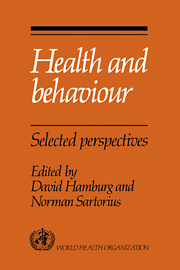Book contents
- Frontmatter
- Contents
- List of contributors
- Preface
- Acknowledgements
- List of abbreviations
- 1 Social and behavioural determinants of mental disorders
- 2 Food-related behaviour
- 3 The psychosocial environment and the development of competence in children
- 4 Children in danger
- 5 Adolescent health care and disease prevention in the Americas
- 6 Social networks and mental disorder (with special reference to the elderly)
- 7 Mental health aspects of general health care
- 8 The sociology of health care in developing countries
- 9 Population movements and health: global research needs
- 10 Health and behaviour: a worldwide perspective
- Index
6 - Social networks and mental disorder (with special reference to the elderly)
Published online by Cambridge University Press: 06 August 2010
- Frontmatter
- Contents
- List of contributors
- Preface
- Acknowledgements
- List of abbreviations
- 1 Social and behavioural determinants of mental disorders
- 2 Food-related behaviour
- 3 The psychosocial environment and the development of competence in children
- 4 Children in danger
- 5 Adolescent health care and disease prevention in the Americas
- 6 Social networks and mental disorder (with special reference to the elderly)
- 7 Mental health aspects of general health care
- 8 The sociology of health care in developing countries
- 9 Population movements and health: global research needs
- 10 Health and behaviour: a worldwide perspective
- Index
Summary
In the preservation of mental health, supportive social networks such as family, neighbours, and friends enjoy increasing importance. The network of personal relationships plays a decisive part in the growth of identity, transmission of social norms and attitudes, decision making, and coping with crises and stressful life events.
Essential elements of the social support concept can already be found in the work of E. Durkheim, who, 90 years ago, examined the influence of societal factors on suicide frequencies. It is these studies that gave rise to the theory of social disintegration. Durkheim explained the integrating function of groups by basically psychological concepts. He noted that if a group is characterized by a low degree of integration, the individual withdraws from the social life of that group and gives precedence to his own goals rather than in those of the group. This leads to a disintegration of the normative nexus of the group and to a reduction in the number of opportunities for effective support. Since Durkheim's time, the concept of ‘social isolation’ rather than his original concept of ‘social disintegration’ has become increasingly important in research on social and psychological conditions of mental health.
Faris & Dunham found high incidences of certain categories of mental disorders in areas of Chicago with a high proportion of single-person households. We were able to confirm these findings in the German industrial city of Mannheim in 1965.
Keywords
- Type
- Chapter
- Information
- Health and BehaviourSelected Perspectives, pp. 150 - 161Publisher: Cambridge University PressPrint publication year: 1989
- 4
- Cited by

